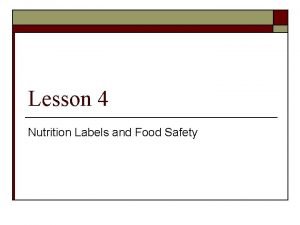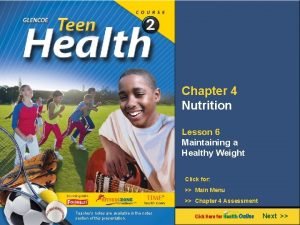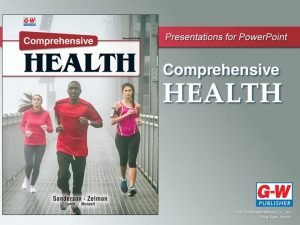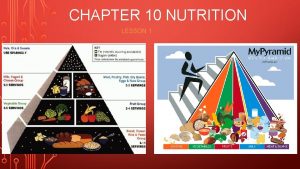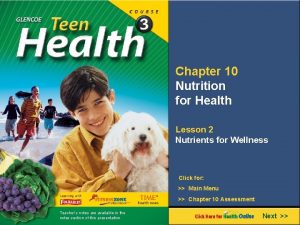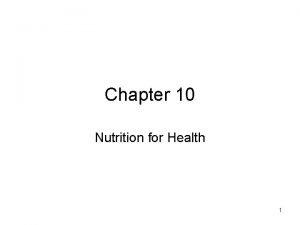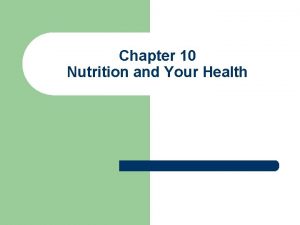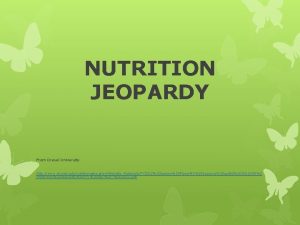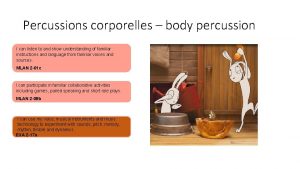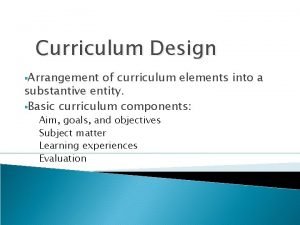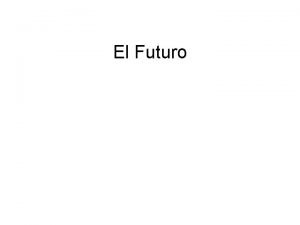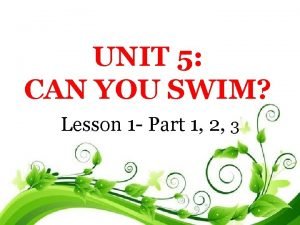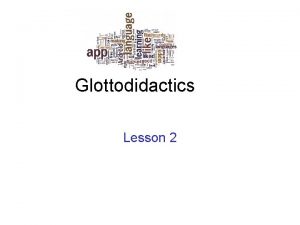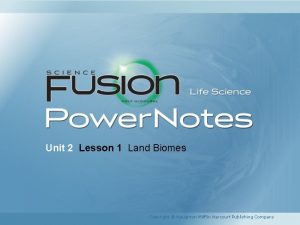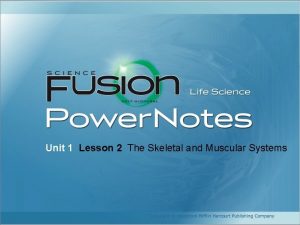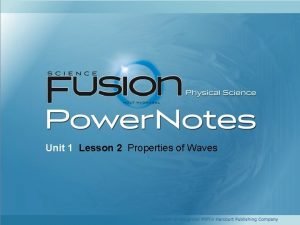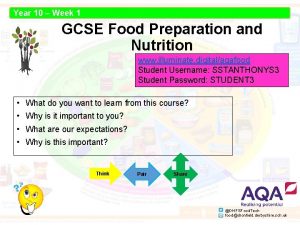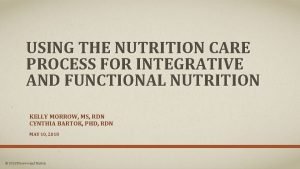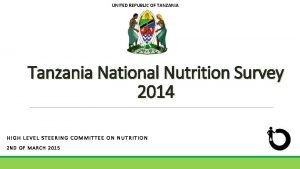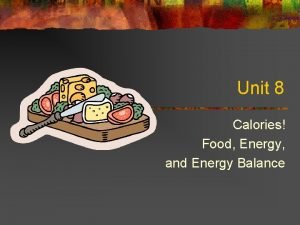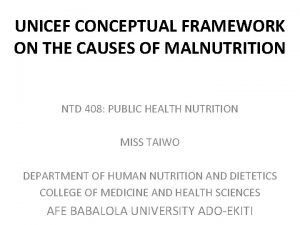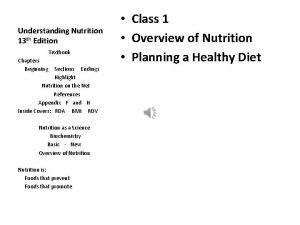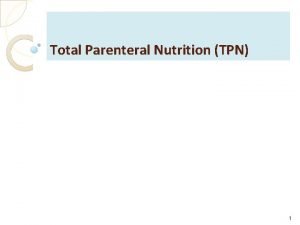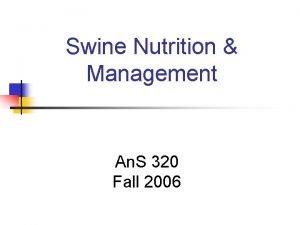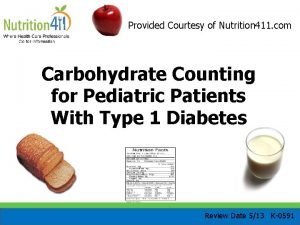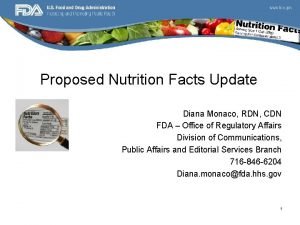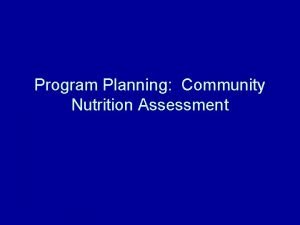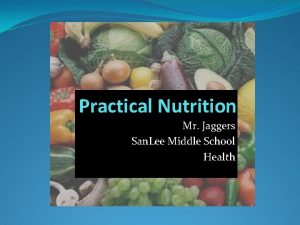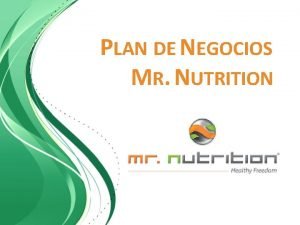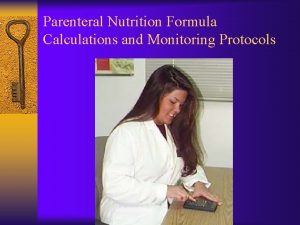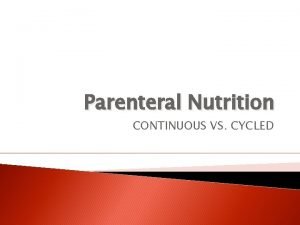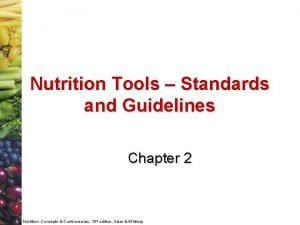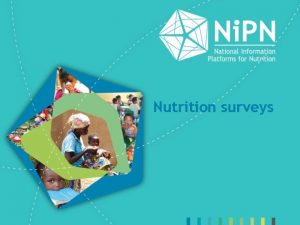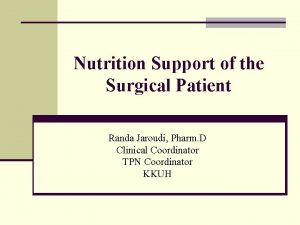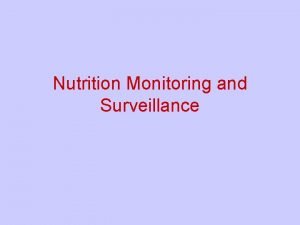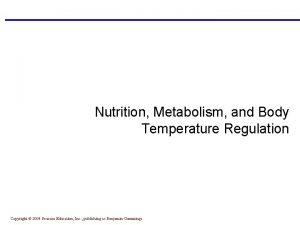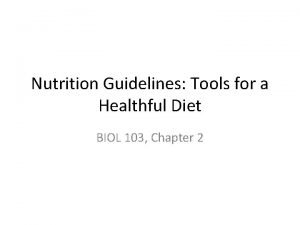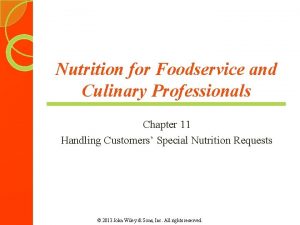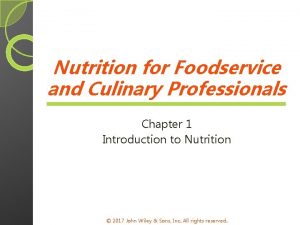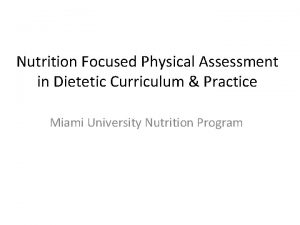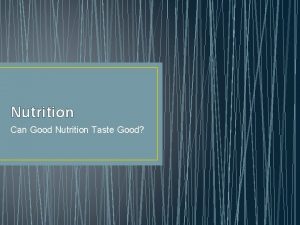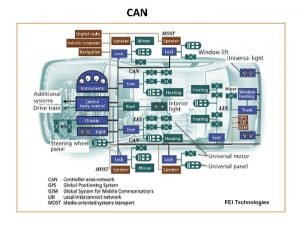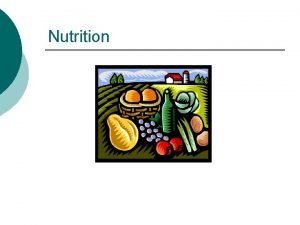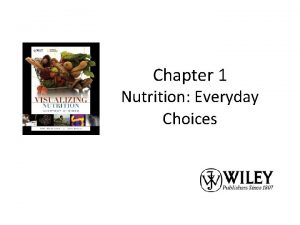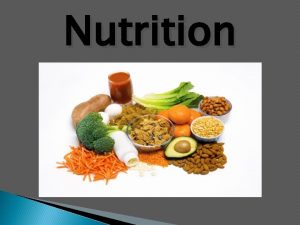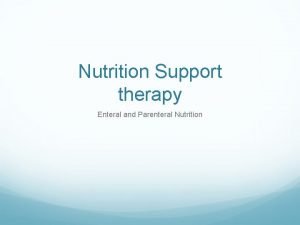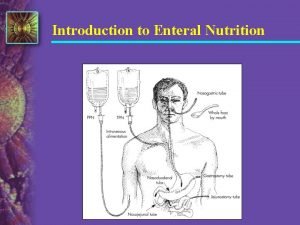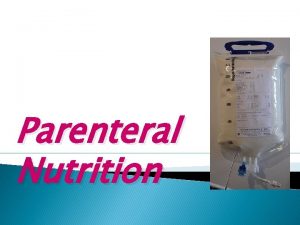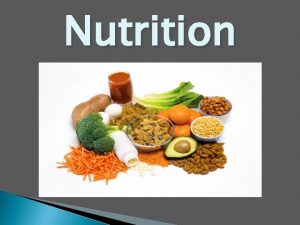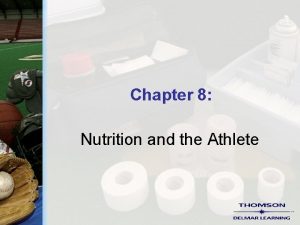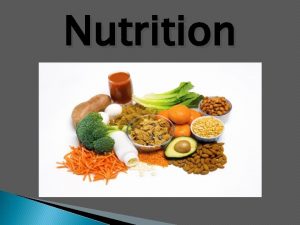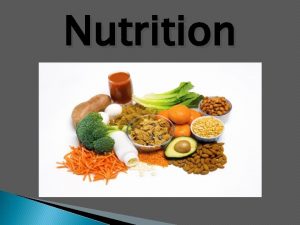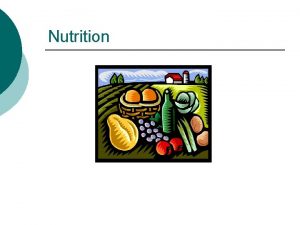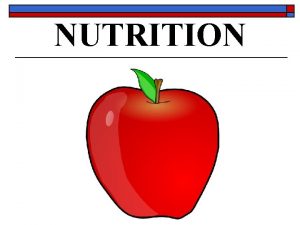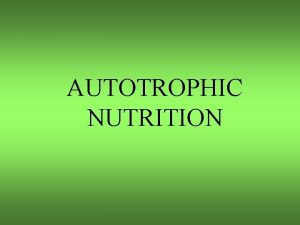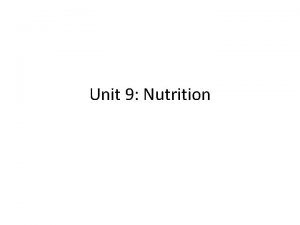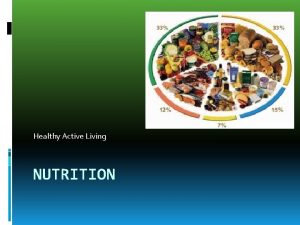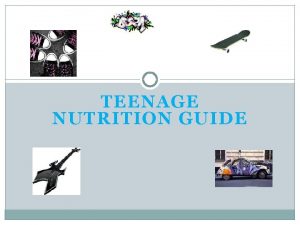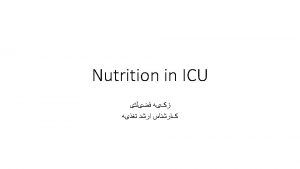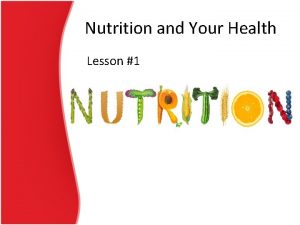LESSON 3 Nutrition LESSON 3 Nutrition How can

















































































- Slides: 81

LESSON 3: Nutrition

LESSON 3: Nutrition How can you improve your nutrition? Think about the “Essential Question” and Quick Write your thoughts in your Cadet Notebook.

LESSON 3: Nutrition Think about what you know about nutrition. Inquire – What do you already know?

LESSON 3: Nutrition (U 2 C 6 L 3: F 1) If “you are what you eat, ” which picture below most accurately represents you? A) B) In the Middle C)

LESSON 3: Nutrition Prepare for this lesson by discussing the key questions of this Student Learning Plan. • What will you accomplish in this lesson? • What will you learn in this lesson? • Why is the lesson important? • When will you have successfully met the lesson’s purpose?

LESSON 3: Nutrition Learning Objectives • Identify common influences on food choices • Describe how the body uses the six types of nutrients • Explain how substances added to foods, such as fats, sugars, and sodium, can impact your health • Explain how to read food labels • Identify key factors in making healthy food choices • Explain how eating right and exercising can impact your health • Define key words: appetite, calories, carbohydrates, cholesterol, electrolytes, essential amino acids, hunger, hydration, legumes, nutrients, obese, protein, saturated fats, trans fats, unsaturated fats

LESSON 3: Nutrition Complete Exercise #1 – Favorite Foods.

LESSON 3: Nutrition Think about why you eat certain foods. Gather - So, what else do you need to know or learn?

LESSON 3: Nutrition Appetite – the psychological desire for food

LESSON 3: Nutrition Hunger – the physical need for food

LESSON 3: Nutrition The Slow Hunger Switch to Your Brain • Your stomach needs about 20 minutes to send a message back to the brain to turn off the hunger switch. • This may cause some people to overeat if they eat too fast while their hunger switch is on. • Eat slowly to allow time for your brain to receive the message that your hunger has been satisfied.

LESSON 3: Nutrition What Influences Your Food Choices?

LESSON 3: Nutrition What Influences Your Food Choices?

LESSON 3: Nutrition Why Your Body Needs Nutritious Foods • Growing new cells, strong bones, teeth, etc. • Energy to do things • Food energy is measured in calories • Healing from illness or injury • Preventing nutrient deficiencies • Young people need more calcium for bone growth

LESSON 3: Nutrition The Breakfast Benefit • Teens who eat breakfast often perform better in school and sports and have healthier weights. • By eating breakfast, you can increase your memory, stay focused, and feel less grouchy and restless.

LESSON 3: Nutrition (U 2 C 6 L 3: Q 1) Which of the following may be stimulated by the smell, sight, or texture of food? A) B) C) D) Craving Appetite Hunger Digestive System Click to see the correct answer

LESSON 3: Nutrition (U 2 C 6 L 3: Q 2) Which of the following is NOT an important role of nutrients? A) B) C) D) They clean the pancreas They give you energy They build new body tissues and repair cells They help your body's processes and systems run smoothly Click to see the correct answer

LESSON 3: Nutrition (U 2 C 6 L 3: Q 3) T or F: Using food to deal with negative emotions is a healthy way to respond to these feelings. A) True B) False Click to see the correct answer

LESSON 3: Nutrition (U 2 C 6 L 3: Q 4) Renee was studying in her room after dinner. Her parents were watching TV in the living room. When Renee walked past the living room to get a glass of water she saw images of a pepperoni pizza and a group of people eating and laughing. By the time Renee got to the kitchen she wanted more than a glass of water. She was craving something salty, crispy, or spicy. What is the most likely influence on Renee’s sudden change in appetite? A) B) C) D) Emotions Personal preferences Food availability Advertising Click to see the correct answer

LESSON 3: Nutrition (U 2 C 6 L 3: Q 5) T or F: Calories are a measure of how overweight you are. A) True B) False Click to see the correct answer

LESSON 3: Nutrition Think about the factors that influence what you eat. Process - Now what can you do with this new information you’ve learned?

LESSON 3: Nutrition • Complete Exercise #2 – Food Influences. • Be prepared to share your answers with the class.

LESSON 3: Nutrition Reflection • Why do you think some people are more easily influenced by others about their food choices? • In your opinion, why are there so many TV food ads for candy and snacks instead of healthy foods?

LESSON 3: Nutrition Gather - So, what else do you need to know or learn? Think about categories of food nutrients.

LESSON 3: Nutrition Read the assigned topic in your student text. • Carbohydrates • Proteins • Fats • Vitamins • Minerals • Water Divide Cadets into six teams

LESSON 3: Nutrition Prepare a short presentation on your assigned topic with your team.

LESSON 3: Nutrition • With your team, present your topic to the class. • Take notes as you listen to the presentations of other teams.

LESSON 3: Nutrition Fiber – the part of fruits, vegetables, grains, and beans that your body cannot digest

LESSON 3: Nutrition • High fiber foods: whole grains, fruits and vegetables, dry beans, and peas • Helps digestion • May lower risk of certain cancers and heart disease

LESSON 3: Nutrition Cholesterol – a waxy substance used by the body to build cells and hormones, and to protect nerve fibers

LESSON 3: Nutrition “Bad” cholesterol (LDL) can clog blood vessels, leading to heart attack or stroke. • Increase LDL levels: fatty meats, full fat dairy products, egg yolks “Good” cholesterol (HDL) can lower LDL levels. • Increase HDL levels: nuts, fatty fish, olive oil Regular aerobic activity can raise HDL levels and prevent LDL buildup.

LESSON 3: Nutrition Hidden Fats – fats added to processed and fast foods

LESSON 3: Nutrition Trans fats are artificial fats made when hydrogen gas reacts with oil. • Found in cookies, crackers, icing, potato chips, margarine, and microwave popcorn • Raise total cholesterol levels • Pose a higher risk of heart disease than saturated fats • Deplete good cholesterol (HDL)

LESSON 3: Nutrition Hidden Sugar – added to many processed foods

LESSON 3: Nutrition • Common in soft drinks, cookies, candy, breakfast cereal. Also added to foods that do not seem sweet. • Adds extra calories and can cause weight gain. • Difficult to identify sugars in processed foods. • anhydrous dextrose, brown sugar, cane crystals, cane sugar, corn sweetener, corn syrup solids, crystal dextrose, evaporated cane juice, fructose sweetener, fruit juice concentrates, high-fructose corn syrup, honey, liquid fructose, malt syrup

LESSON 3: Nutrition Sodium – helps control the balance of fluids in the body

LESSON 3: Nutrition • Found naturally in salt and other foods • Added to processed foods in large amounts • Too much sodium—high blood pressure and fluid retention The American Heart Association recommends you not consume more than 1, 500 milligrams (mgs) of sodium per day.

LESSON 3: Nutrition Caffeine – stimulates the nervous system

LESSON 3: Nutrition • Found naturally in coffee, tea, and chocolate • Added to soft drinks and “energy” drinks • Can perk you up briefly, but then makes you feel drowsy so that you want more

LESSON 3: Nutrition (U 2 C 6 L 3: Q 6) Where do nutritionists recommend that 45 to 65 percent of your daily calories come from? A) B) C) D) Vitamins Fat Protein Carbohydrates Click to see the correct answer

LESSON 3: Nutrition (U 2 C 6 L 3: Q 7) Which types of fats are found mostly in animal and dairy products such as red meat, butter, cheese, and whole milk? A) B) C) D) Unsaturated fats Saturated fats Trans fats Amino acids Click to see the correct answer

LESSON 3: Nutrition (U 2 C 6 L 3: Q 8) Which types of fats come mainly from plant sources including vegetable oils, nuts, avocados, and olives? A) B) C) D) Unsaturated fats Saturated fats Trans fats Amino acids Click to see the correct answer

LESSON 3: Nutrition (U 2 C 6 L 3: Q 9) What makes up over half of your body and serves many important functions? A) B) C) D) Minerals Fats Protein Water Click to see the correct answer

LESSON 3: Nutrition (U 2 C 6 L 3: Q 10) Vitamin A promotes healthy skin and normal vision. What are good sources for this vitamin? A) B) C) D) Fatty fish Citrus fruits Whole grain breads Dark green leafy vegetables Click to see the correct answer

LESSON 3: Nutrition (U 2 C 6 L 3: Q 11) What mineral is needed to build strong bones and teeth? A) B) C) D) Calcium Zinc Iron Potassium Click to see the correct answer

LESSON 3: Nutrition (U 2 C 6 L 3: Q 12) Which type of fat poses a higher risk of heart disease? A) B) C) D) Trans fat Saturated fat Unsaturated fat Hidden fat Click to see the correct answer

LESSON 3: Nutrition (U 2 C 6 L 3: Q 13) Which nutrient helps control the balance of fluids in the body? A) B) C) D) Sugar Caffeine Sodium Fiber Click to see the correct answer

LESSON 3: Nutrition Think about how to know what is in the foods you are eating. Gather - So, what else do you need to know or learn?

LESSON 3: Nutrition Labeling 1. Ingredients Listed in order of the most used ingredient

LESSON 3: Nutrition Labeling 2. Nutrition Facts Serving size, calories from fat A chart that compares the food to the *percent of the recommended daily amount of a nutrient provided in a serving of food. *Percent Daily Value is based on an intake of 2, 000 calories per day.

LESSON 3: Nutrition Labeling Analysis A food may contain 12% of the recommended daily allowance for fat. But if it gets 72 calories from fat and the total calories are 230 —this is a high fat food: more than a third of it’s calories are from fat!

LESSON 3: Nutrition • Read the “Making Wise Food Choices” and “Finding Your Food/Exercise Balance” sections in your student text. • Take notes in your Cadet Notebook.

LESSON 3: Nutrition (U 2 C 6 L 3: Q 14) T or F: The ingredients on food labels are listed in alphabetical order. A) True B) False Click to see the correct answer

LESSON 3: Nutrition (U 2 C 6 L 3: Q 15) T or F: The Nutrition Facts label clearly identifies foods as high-fat or low-fat. A) True B) False Click to see the correct answer

LESSON 3: Nutrition (U 2 C 6 L 3: Q 16) If you are making wise food choices based on Choose My Plate, you’ll fill _____ of your plate with fruits and vegetables. A) B) C) D) half one-third one-fourth one-tenth Click to see the correct answer

LESSON 3: Nutrition Think about analyzing the nutrients in different foods. Process - Now what can you do with this new information you’ve learned?

LESSON 3: Nutrition Complete Exercise #3 – How Much Sugar.

LESSON 3: Nutrition Review your answers with your class.

LESSON 3: Nutrition With your team, complete Exercise #4 – Food Labels. Divide Cadets into small teams

LESSON 3: Nutrition Be prepared to share your answers with the class.

LESSON 3: Nutrition Reflection • From what you’ve learned about hidden sugars, do you think it would be easy to eat one full cup of sugar in a day? • Have you read food labels in the past? Will you read them now? Explain your answers. • What surprised you most about the answers to the two exercises you completed?

LESSON 3: Nutrition Think about changes you want to make in your eating habits. Apply - What else can you do with what you’ve learned today?

LESSON 3: Nutrition • Review your answers to Exercise #1 – Favorite Foods and make notes about things you want to change. • Read Information Sheet #1 – Food Plan. • Complete Exercise #5 – Evaluate Your Nutrition.

LESSON 3: Nutrition Performance Assessment Task • Complete the Nutrition Performance Assessment Task. • Submit your completed performance assessment task to your instructor feedback and a grade.

LESSON 3: Nutrition Insert Keywords HTML page with links to the games the CPS questions

LESSON 3: Nutrition (U 2 C 6 L 3: V 1) Appetite is _____. A) food you like to eat B) the body’s signal that you need to eat something C) the psychological desire for food Click to see the correct answer

LESSON 3: Nutrition (U 2 C 6 L 3: V 2) A measure of the energy in food is _____. A) B) C) D) calories fat carbohydrates portion Click to see the correct answer

LESSON 3: Nutrition (U 2 C 6 L 3: V 3) _____ are the sugars and starches that provide your body with most of its energy. A) B) C) D) Proteins Carbohydrates Fats Cholesterol Click to see the correct answer

LESSON 3: Nutrition (U 2 C 6 L 3: V 4) A waxy substance used by the body to build cells and hormones, and to protect nerve fibers is _____. A) B) C) D) saturated fat essential amino acids cholesterol legumes Click to see the correct answer

LESSON 3: Nutrition (U 2 C 6 L 3: V 5) _____ are substances that help control fluid levels and maintain normal potassium levels in the body. A) B) C) D) Trans fat Essential amino acids Legumes Electrolytes Click to see the correct answer

LESSON 3: Nutrition (U 2 C 6 L 3: V 6) _____ are small units that make up protein that the body cannot make – they must come from the food you eat. A) B) C) D) Minerals Essential amino acids Vitamins Unsaturated fats Click to see the correct answer

LESSON 3: Nutrition (U 2 C 6 L 3: V 7) The physical need for food is called _____. A) B) C) D) hunger taste diet nutrition Click to see the correct answer

LESSON 3: Nutrition (U 2 C 6 L 3: V 8) Hydration is _____. A) providing enough water to maintain a correct fluid balance B) eating enough fiber to maintain good digestion C) limiting salt intake to avoid water retention Click to see the correct answer

LESSON 3: Nutrition (U 2 C 6 L 3: V 9) Legumes are a group of vegetables that _____. A) reduce good cholesterol B) contain high amounts of unsaturated fats C) includes beans, peas, and lentils Click to see the correct answer

LESSON 3: Nutrition (U 2 C 6 L 3: V 10) Substances in food that your body needs are called _____. A) B) C) D) proteins nutrients vitamins minerals Click to see the correct answer

LESSON 3: Nutrition (U 2 C 6 L 3: V 11) Obese means _____. A) B) C) D) very thin very overweight unhealthy sedentary Click to see the correct answer

LESSON 3: Nutrition (U 2 C 6 L 3: V 12) Protein is a nutrient your body uses to _____. A) build, repair, and maintain cells and tissues B) give you quick energy C) build strong bones and healthy teeth Click to see the correct answer

LESSON 3: Nutrition (U 2 C 6 L 3: V 13) Fats that are solid at room temperature are _____. A) B) C) D) trans fats unsaturated fats “bad” cholesterol saturated fats Click to see the correct answer

LESSON 3: Nutrition (U 2 C 6 L 3: V 14) _____ are artificial fats made when hydrogen gas reacts with oil. A) Unsaturated fats B) Trans fats C) Polyunsaturated fats Click to see the correct answer

LESSON 3: Nutrition (U 2 C 6 L 3: V 15) Unsaturated fats are fats that _____. A) are liquid at room temperature B) contain no cholesterol C) occur naturally in fatty meats Click to see the correct answer

LESSON 3: Nutrition How can you improve your nutrition? Think about the Essential Question and revise your original answer to the Quick Write.
 Datingoo
Datingoo Unit 3 nutrition lesson 6 anorexia nervosa and bulimia
Unit 3 nutrition lesson 6 anorexia nervosa and bulimia Lesson 4 weight control
Lesson 4 weight control Chapter 10 nutrition for health lesson 1 answer key
Chapter 10 nutrition for health lesson 1 answer key Chapter 10 nutrition for health lesson 2 nutrients
Chapter 10 nutrition for health lesson 2 nutrients Chapter 10 lesson 1 the importance of nutrition
Chapter 10 lesson 1 the importance of nutrition Chapter 10 lesson 4 nutrition labels and food safety
Chapter 10 lesson 4 nutrition labels and food safety Drexel university nutrition lesson plans
Drexel university nutrition lesson plans If you can imagine it you can achieve it
If you can imagine it you can achieve it Kinds of comparison
Kinds of comparison If you think you can you can poem
If you think you can you can poem If you cant measure it you can't improve it
If you cant measure it you can't improve it If you can’t measure it, you can’t manage it
If you can’t measure it, you can’t manage it Percussions corporelles
Percussions corporelles The arrangement of the elements of curriculum
The arrangement of the elements of curriculum You can tell harris about it just ____(easily) as i can
You can tell harris about it just ____(easily) as i can How to be more impressive 1+1=2
How to be more impressive 1+1=2 He can speak
He can speak Look at the pictures and complete with can or can't
Look at the pictures and complete with can or can't Going on a bear hunt dr. jean
Going on a bear hunt dr. jean Through you i can do anything i can do all things
Through you i can do anything i can do all things If you can't measure it you cannot improve it
If you can't measure it you cannot improve it Already can or can already
Already can or can already Any fool can write code that a computer can understand
Any fool can write code that a computer can understand Shall i compare thee figures of speech
Shall i compare thee figures of speech Liquide mittel
Liquide mittel Modal verbs inability
Modal verbs inability Lan can't swim fast
Lan can't swim fast What are the things we can learn from ants
What are the things we can learn from ants Lesson outline lesson 3 describing circuits answers
Lesson outline lesson 3 describing circuits answers Mountain building
Mountain building Lesson outline lesson 2 aquatic ecosystems answer key
Lesson outline lesson 2 aquatic ecosystems answer key Micro-lesson
Micro-lesson L 101 lesson 2
L 101 lesson 2 Lesson plan of lesson a gift of chappals
Lesson plan of lesson a gift of chappals Lesson 1 your total health
Lesson 1 your total health Weather forecasts lesson 3 outline answers
Weather forecasts lesson 3 outline answers Sat vocabulary lesson 4
Sat vocabulary lesson 4 Physical properties lesson 2
Physical properties lesson 2 Lesson 1 thermal energy and the behavior of matter
Lesson 1 thermal energy and the behavior of matter Climates of earth lesson 1 answer key
Climates of earth lesson 1 answer key Lesson outline lesson 1
Lesson outline lesson 1 Lesson 1 understanding science answer key
Lesson 1 understanding science answer key Fingerprint galton details
Fingerprint galton details Lesson 1 land biomes answer key
Lesson 1 land biomes answer key Lesson 4 gravity and motion lesson review
Lesson 4 gravity and motion lesson review Lesson outline lesson 2 the muscular system answer key
Lesson outline lesson 2 the muscular system answer key Wave properties lesson 2
Wave properties lesson 2 Today's lesson or today lesson
Today's lesson or today lesson 1 important lesson that is worth sharing about this lesson
1 important lesson that is worth sharing about this lesson Today's lesson or today lesson
Today's lesson or today lesson Lesson outline lesson 1 magnets and magnetic fields
Lesson outline lesson 1 magnets and magnetic fields Lesson outline lesson 3 eclipses and tides answer key
Lesson outline lesson 3 eclipses and tides answer key Gcse food tech high skill dishes
Gcse food tech high skill dishes Nutrition care process
Nutrition care process Tanzania national nutrition survey 2020
Tanzania national nutrition survey 2020 Tanzania national nutrition survey 2020
Tanzania national nutrition survey 2020 Biobeyond unit 8 counting calories
Biobeyond unit 8 counting calories Unicef conceptual framework for malnutrition explained
Unicef conceptual framework for malnutrition explained Understanding nutrition 13th edition rental
Understanding nutrition 13th edition rental Tpn injection
Tpn injection Swine nutrition management
Swine nutrition management Specialized nutrition support
Specialized nutrition support Nutrition411
Nutrition411 Monaco drink nutrition facts
Monaco drink nutrition facts Nutrition program planning
Nutrition program planning Benefits of astaxanthin
Benefits of astaxanthin Jaggers menu calories
Jaggers menu calories Mr nutrition el palo
Mr nutrition el palo Tpn calculations
Tpn calculations Tpn cycling
Tpn cycling Healthypeopleenergy
Healthypeopleenergy Types of nutrition survey
Types of nutrition survey Complication of parenteral nutrition
Complication of parenteral nutrition Nutrition words
Nutrition words Nutrition monitoring definition
Nutrition monitoring definition Temperature regulation
Temperature regulation Photosynthesis learning objectives
Photosynthesis learning objectives Ul tolerable upper intake level
Ul tolerable upper intake level Chapter 11 culinary nutrition
Chapter 11 culinary nutrition Nutrition for foodservice and culinary professionals
Nutrition for foodservice and culinary professionals Nutrition assessment
Nutrition assessment
